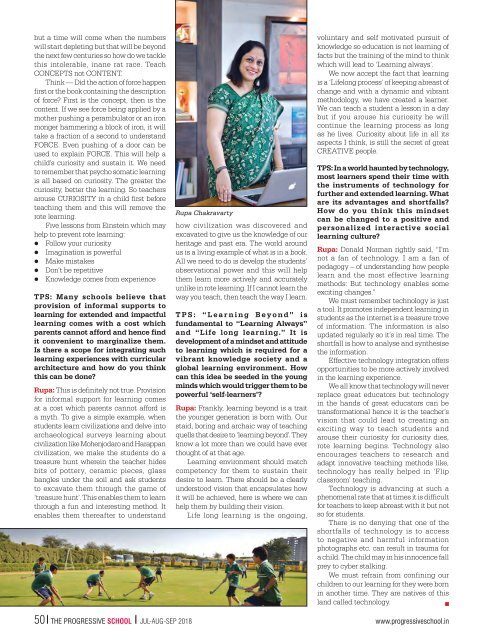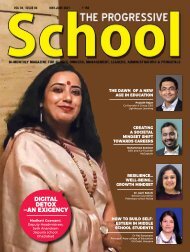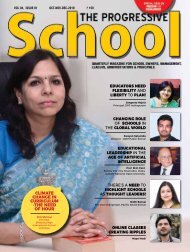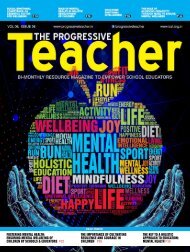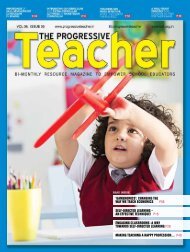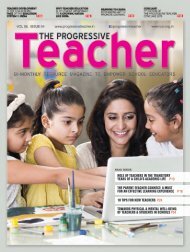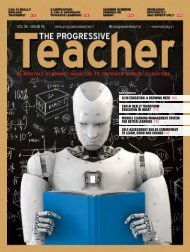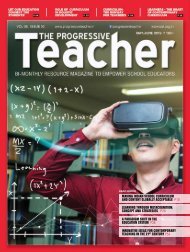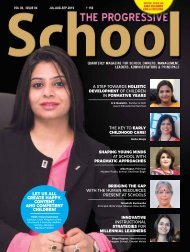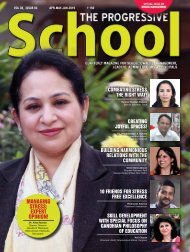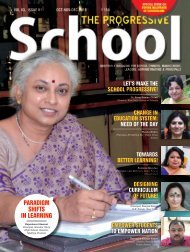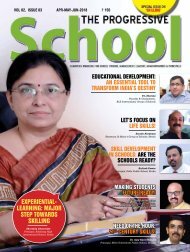The Progressive School Vol 02 Issue 04
The Progressive School is a quarterly magazine for school owners, leaders and principals. It will continue to address vital issues that impact the emerging challenges in the design, administration and growth of schools in all its dimension.
The Progressive School is a quarterly magazine for school owners, leaders and principals. It will continue to address vital issues that impact the emerging challenges in the design, administration and growth of schools in all its dimension.
Create successful ePaper yourself
Turn your PDF publications into a flip-book with our unique Google optimized e-Paper software.
ut a time will come when the numbers<br />
will start depleting but that will be beyond<br />
the next few centuries so how do we tackle<br />
this intolerable, inane rat race. Teach<br />
CONCEPTS not CONTENT.<br />
Think — Did the action of force happen<br />
first or the book containing the description<br />
of force? First is the concept, then is the<br />
content. If we see force being applied by a<br />
mother pushing a perambulator or an iron<br />
monger hammering a block of iron, it will<br />
take a fraction of a second to understand<br />
FORCE. Even pushing of a door can be<br />
used to explain FORCE. This will help a<br />
child’s curiosity and sustain it. We need<br />
to remember that psycho somatic learning<br />
is all based on curiosity. <strong>The</strong> greater the<br />
curiosity, better the learning. So teachers<br />
arouse CURIOSITY in a child first before<br />
teaching them and this will remove the<br />
rote learning.<br />
Five lessons from Einstein which may<br />
help to prevent rote learning:<br />
• Follow your curiosity<br />
• Imagination is powerful<br />
• Make mistakes<br />
• Don’t be repetitive<br />
• Knowledge comes from experience<br />
TPS: Many schools believe that<br />
provision of informal supports to<br />
learning for extended and impactful<br />
learning comes with a cost which<br />
parents cannot afford and hence find<br />
it convenient to marginalize them.<br />
Is there a scope for integrating such<br />
learning experiences with curricular<br />
architecture and how do you think<br />
this can be done?<br />
Rupa: This is definitely not true. Provision<br />
for informal support for learning comes<br />
at a cost which parents cannot afford is<br />
a myth. To give a simple example, when<br />
students learn civilizations and delve into<br />
archaeological surveys learning about<br />
civilization like Mohenjodaro and Harappan<br />
civilization, we make the students do a<br />
treasure hunt wherein the teacher hides<br />
bits of pottery, ceramic pieces, glass<br />
bangles under the soil and ask students<br />
to excavate them through the game of<br />
‘treasure hunt’. This enables them to learn<br />
through a fun and interesting method. It<br />
enables them thereafter to understand<br />
Rupa Chakravarty<br />
how civilization was discovered and<br />
excavated to give us the knowledge of our<br />
heritage and past era. <strong>The</strong> world around<br />
us is a living example of what is in a book.<br />
All we need to do is develop the students’<br />
observational power and this will help<br />
them learn more actively and accurately<br />
unlike in rote learning. If I cannot learn the<br />
way you teach, then teach the way I learn.<br />
TPS: “Learning Beyond” is<br />
fundamental to “Learning Always”<br />
and “Life long learning.” It is<br />
development of a mindset and attitude<br />
to learning which is required for a<br />
vibrant knowledge society and a<br />
global learning environment. How<br />
can this idea be seeded in the young<br />
minds which would trigger them to be<br />
powerful ‘self-learners’?<br />
Rupa: Frankly, learning beyond is a trait<br />
the younger generation is born with. Our<br />
staid, boring and archaic way of teaching<br />
quells that desire to ‘learning beyond’. <strong>The</strong>y<br />
know a lot more than we could have ever<br />
thought of at that age.<br />
Learning environment should match<br />
competency for them to sustain their<br />
desire to learn. <strong>The</strong>re should be a clearly<br />
understood vision that encapsulates how<br />
it will be achieved, here is where we can<br />
help them by building their vision.<br />
Life long learning is the ongoing,<br />
voluntary and self motivated pursuit of<br />
knowledge so education is not learning of<br />
facts but the training of the mind to think<br />
which will lead to ‘Learning always’.<br />
We now accept the fact that learning<br />
is a ‘Lifelong process’ of keeping abreast of<br />
change and with a dynamic and vibrant<br />
methodology, we have created a learner.<br />
We can teach a student a lesson in a day<br />
but if you arouse his curiosity he will<br />
continue the learning process as long<br />
as he lives. Curiosity about life in all its<br />
aspects I think, is still the secret of great<br />
CREATIVE people.<br />
TPS: In a world haunted by technology,<br />
most learners spend their time with<br />
the instruments of technology for<br />
further and extended learning. What<br />
are its advantages and shortfalls?<br />
How do you think this mindset<br />
can be changed to a positive and<br />
personalized interactive social<br />
learning culture?<br />
Rupa: Donald Norman rightly said, “I’m<br />
not a fan of technology. I am a fan of<br />
pedagogy – of understanding how people<br />
learn and the most effective learning<br />
methods: But technology enables some<br />
exciting changes.”<br />
We must remember technology is just<br />
a tool. It promotes independent learning in<br />
students as the internet is a treasure trove<br />
of information. <strong>The</strong> information is also<br />
updated regularly so it’s in real time. <strong>The</strong><br />
shortfall is how to analyse and synthesise<br />
the information.<br />
Effective technology integration offers<br />
opportunities to be more actively involved<br />
in the learning experience.<br />
We all know that technology will never<br />
replace great educators but technology<br />
in the hands of great educators can be<br />
transformational hence it is the teacher’s<br />
vision that could lead to creating an<br />
exciting way to teach students and<br />
arouse their curiosity for curiosity dies,<br />
rote learning begins. Technology also<br />
encourages teachers to research and<br />
adapt innovative teaching methods like,<br />
technology has really helped in ‘Flip<br />
classroom’ teaching.<br />
Technology is advancing at such a<br />
phenomenal rate that at times it is difficult<br />
for teachers to keep abreast with it but not<br />
so for students.<br />
<strong>The</strong>re is no denying that one of the<br />
shortfalls of technology is to access<br />
to negative and harmful information<br />
photographs etc. can result in trauma for<br />
a child. <strong>The</strong> child may in his innocence fall<br />
prey to cyber stalking.<br />
We must refrain from confining our<br />
children to our learning for they were born<br />
in another time. <strong>The</strong>y are natives of this<br />
land called technology.<br />
50 THE PROGRESSIVE SCHOOL JUL-AUG-SEP 2018<br />
www.progressiveschool.in


